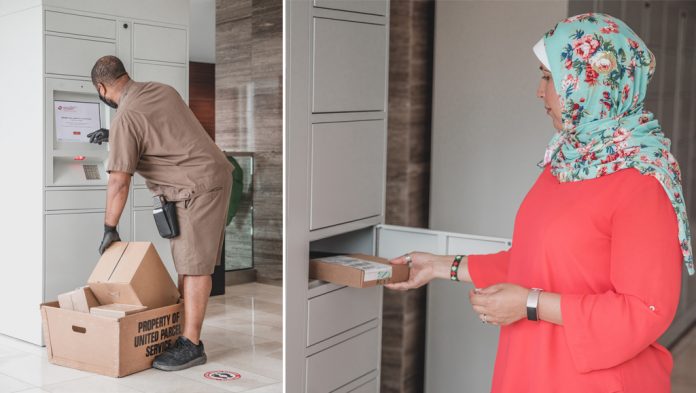Remember the days when a delivery driver used to leave a package in a parcel room or an old-school mechanical steel lock-and-key depository in the lobby? If you are still using just a parcel room to store deliveries, be sure to read the pitfalls here.
Parcel lockers and parcel rooms have come a long way, now falling into the category of a SaaS or software as a service model. Consumers expect a whole lot more from their parcel management system, such as real-time notifications, access via their smartphone, and even the option to leave items in their locker for collection and return.
With that in mind, Canadian companies looking for a parcel locker or room supplier in Canada are faced with a number of factors to consider. If you’re looking to choose a resident delivery management solution that can deliver the service people want and expect in 2021 and beyond, read on for what you need to know.
Parcel lockers and rooms in 2021: What do people want?
As the volume of e-commerce purchases has continued to grow, so has the number of parcel delivery companies (Amazon uses more than 12 carriers in Canada alone). Therefore, we need even more sophisticated parcel delivery solutions to receive and process data from multiple sources.
Multi-family residences demand seamless access to their deliveries from lockers & rooms in condominiums, apartment blocks, high-rise towers, school campuses, and student housing. Users want to pick up their parcels from a secure location when they shop online. Rather than keep a key, locker users now expect to access their items via the internet from a smart device, necessitating cloud storage for critical data and smart receptacles driven by printed circuit boards, firmware, and software.
Parcel locker and smart parcel room suppliers need to have:
- Compliance with Canada’s Anti-Spam Legislation (CASL)
- Established contracts with delivery companies in Canada
- Software that integrates with property management software to allow instant access to residents’ personal details to send notifications
- Software sophisticated enough to accommodate returns of e-commerce items and collection of new outbound parcels
- Data hosting in Canada to protect Personally Identifiable Information (PII)
- A multi-tiered approach to data security and privacy
- Liability insurance that pays out in Canada
- Commercially accepted best practices governing procedures for company-owned software upgrades, maintenance, and fixes (i.e. ISO 27001 and SOC II)
- Experienced staff to offer remote and on-sire support within Canada
In addition, the best solutions will:
- Comply with Canadian Electrical Code and Fire Code ratings
- Accommodate disabilities — for example, wheelchair users and visually impaired people
- Incorporate commercial-grade screens
- Be adequately constructed to prevent theft
- Have compartment content detection
- Have motorized locks
- Have child safety locks for internal release
Let’s look at each of these factors in more detail to help you decide on the most appropriate supplier for you.
Contracts with Canadian delivery companies
Probably the most important consideration for smart lockers and rooms is whether or not they will be used systemically by Canadian delivery companies. Rather than just being a case of a delivery driver electing to use a locker, the actual delivery corporation must sanction, under contract, every single delivery.
Established delivery contracts ensure Canadian delivery companies:
- Have tested and approved the locker or room
- Know in advance that they must identify a parcel locker or room at the location to complete deliveries
- Will deposit the parcel in the right locker at the municipal address
- Accept liability for the parcel as they would in the standard course of business
- Know there is contractual recourse and remedies if the delivery driver fails to deliver to the locker
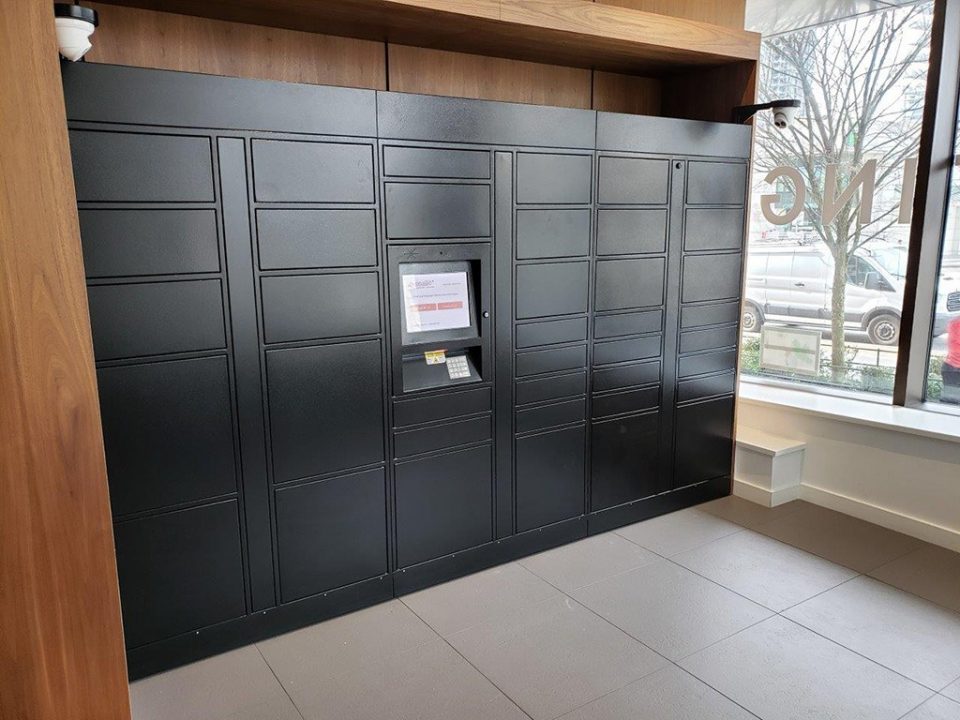
Parcel lockers or parcel rooms?
Parcel rooms appear more effective on paper than in reality. A major drawback is that carriers tend to dump parcel deliveries for multiple different residents in the room without notifying each resident that their parcel has arrived. For instance, a carrier has deliveries for units 302, 407, 621, and 801. They gain access to the room using the details for unit 302’s delivery only. The carrier is busy as usual and short on time, so they leave the deliveries for 302, 407, 621, and 801 in the parcel room without entering each resident’s details into the system, this practice is easy and therefore becomes habitual. As a result, only the resident living in 302 knows to come and collect their parcel.
The net effect is that packages end up piling up in the parcel room because only one resident in each batch is notified of their delivery: the person whose details the delivery person used to gain access to the room. The rest of the parcels accumulate which then invites confusion, theft, and potential damage.
Read more about parcel room best practices: click here
Parcel pickups and returns
The next step in parcel locker innovation is for end-users to be able to return a parcel or ship out a new package via their locker. In addition, parcel lockers are ideal receptacles for other essential services requiring items to be collected and deposited, such as dry cleaning and laundry. To facilitate the collection of items, parcel locker suppliers need contracts in place with parcel carriers, plus software integration, so that carriers are notified of a pickup request that they need to act on.
Ask Snaile what additional services their lockers provide residents.
Data hosting in Canada
The cloud data hosting location is an important factor when choosing a parcel locker or smart room supplier in Canada. Yet, it is often overlooked and usually not disclosed by US and foreign companies.
The reason data hosting in Canada is so essential is down to the rules that govern the protection of personal information. All countries have their own laws designed to protect Personally Identifiable Information (PII), which can include details such as names, cellphone numbers, addresses, and email addresses.
Regulations differ between countries, with some locations being stricter than others. In Canada, PII is strictly protected under the Personal Information Protection and Electronic Documents Act (PIPEDA), but data must be hosted in Canada for PIPEDA to apply. If, for example, PII data leaves Canada and goes to the US, then the US Patriot Act will apply. The problem here is that the US Patriot Act has much broader liberties than PIPEDA and would risk violating Canadian laws.
Make sure your supplier can prove its data hosting location, ask Snaile where and how they host data in Canada.
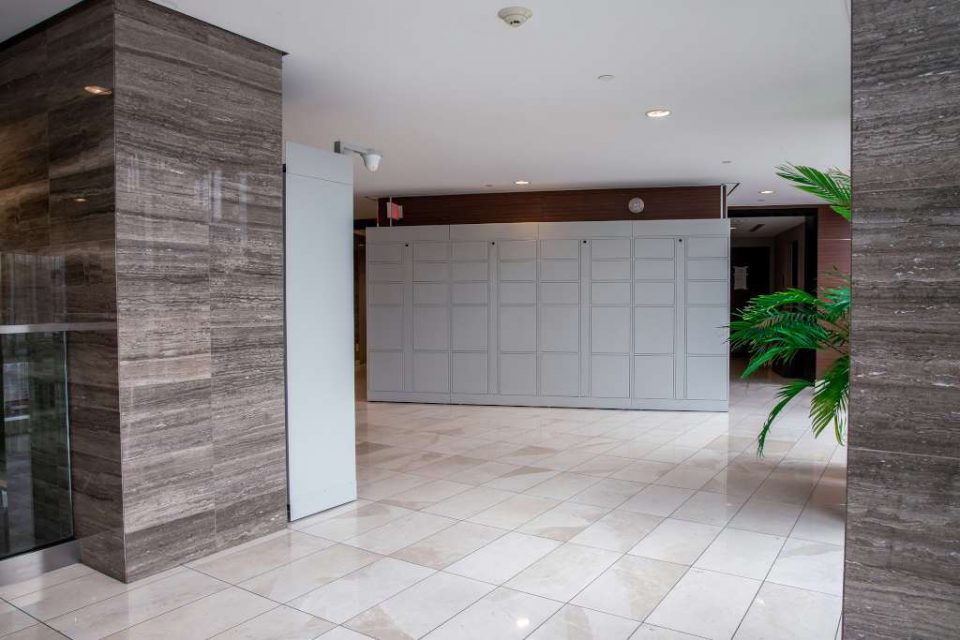
Data security
A parcel locker company should have a multi-tiered approach to data security and privacy, including the following:
- ISO-27001 information and security certification to ensure compliance with industry-leading standards set by subject matter experts.
- SOC 2 compliance from a SaaS provider, an auditing procedure that ensures service providers securely manage a company’s data to protect the organization’s interests and its client’s privacy.
- Ongoing third-party penetration testing in which an ethical hacking company attempts to break into the parcel locker supplier’s software. The third party then provides remediation reports according to what issues they find.
- Cyber insurance to protect your company, your end-users, and the parcel locker provider in the event that anything goes wrong. The policy should pay out in Canada for Canadian breaches.
- A Chief Information Security Officer (CISO) — a dedicated, seasoned executive abreast of legal and best practice requirements for data privacy and security compliance in Canada.
Meet Snaile’s CISO – click here, and read more about how Snaile deals with security, by clicking here.
Integration with property management and building automation software
For a parcel locker to send out pickup codes and reminders to end-users, they will need access to PII, which in Canada is protected under PIPEDA.
There are two options here:
- Integration with building management software. If you integrate your parcel lockers, usually by API, to your property management or building automation system, you will need only to maintain your building software. Your parcel lockers will simply call in automatically for updates. Residents will be able to specify how they are notified when a delivery takes place — for example, whether they prefer an email or cellphone notification. Popular software in Canada include 1VALET, BuildingLink, Building Stack, ConciergePlus, Condo Control, Condo Manager, Entrata, MyCondoLink, Mosino, MaxCondoClub, Payquad, PropertyVista, SmartOne, UpperBee, Walter, Yardi & Yuhu.
- Maintaining two separate systems. Otherwise, you will need to maintain two software systems — the property management software and the parcel locker resident roster — which is double the work for you.
See Snaile’s integration partners – click here
Compliance with Canada’s Anti-Spam Legislation (CASL)
Since parcel lockers send out emails or text messages to end users in order to supply locker pickup codes, it is important that those electronic message follow Canada’s Anti-Spam Legislation (CASL). These laws are specific to Canada, so foreign suppliers typically don’t follow Canadian laws, but rather their own laws. When CASL is not followed then often the telecommunication companies like Rogers, Bell and Telus block the text messages from going through their networks. CASL is specific about how a text message is formulated, its length, verbiage, help prompts, unsubscribe prompts, and published policies online dealing with text messaging. Check that your parcel locker and parcel room supplier is compliant with Canada’s Anti-Spam Legislation (CASL) and has a Chief Information Security Officer to ensure future compliance when CASL is updated.
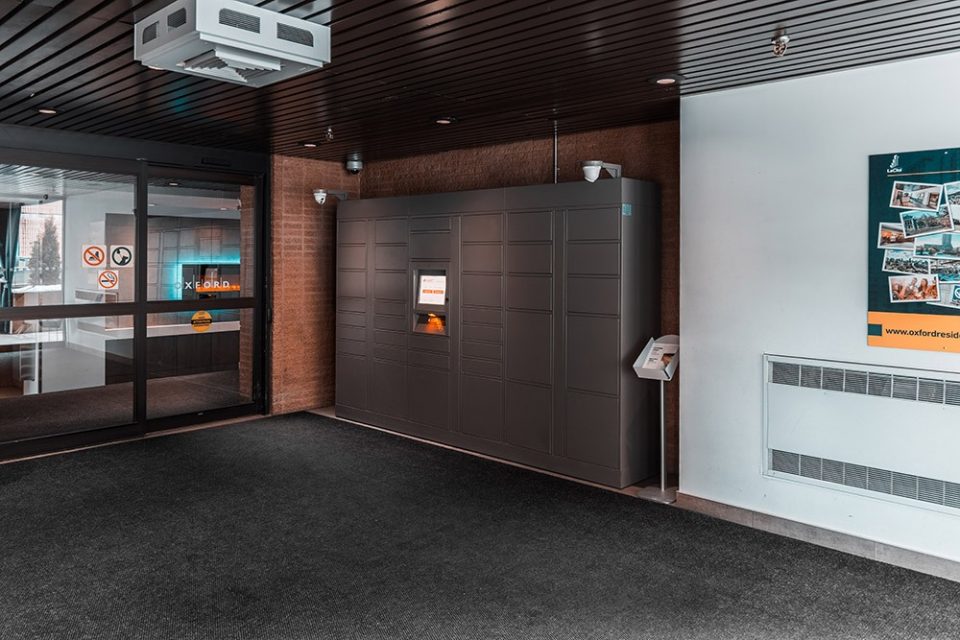
Canadian liability insurance
Your parcel locker supplier will need the following policies that pay out in Canada:
- Commercial Product Liability Insurance. Members of the public will use the parcel lockers, and the lockers are likely to be hosted in a commercial business’s premises. 2 million Canadian dollars is a respectable amount of coverage, but good coverage should be 5 million.
- Cyber Insurance Policy. Parcel lockers are a SaaS model, and they host PII, so need to be protected if any data breach were to occur. A minimum coverage of 2 million Canadian dollars is ideal.
- Professional Liability Coverage. This form of liability insurance helps protect professional advice-and-service-providing individuals and companies from bearing the total costs of defending a client’s negligence claim and any damages awarded. A 2 million dollar coverage is a good starting point.
Ask Snaile for its insurance certificates.
Company-owned software
Many Canadian locker suppliers are reselling lockers with software made by another company, often in another country. The problem is parcel lockers are as much about the software that facilitates their seamless operation as they are about the hardware. In other words, if something goes wrong with the locker door or the lock, most companies will be able to fix the issue without too much of a problem. However, it’s a different thing altogether when it comes to the software.
The software controls the locker terminal itself, the cloud application where data is stored, the notifications sent out to end-users, the triggering of actions at the locker (i.e., opening a specific compartment), etc. And the software is proprietary to the company that made it, so it cannot be serviced by a reseller. It would be like asking your local IT person to fix an issue with Microsoft Windows in the source code when what you really need is a software patch from Microsoft itself. If no patch exists, your IT person’s hands are tied.
The same applies to parcel lockers. The source code is not available to resellers, which means they cannot access fixes, upgrades, maintenance, new integrations (i.e., property management software/building automation), and new hosting locations (i.e., host in Canada). Also, resellers cannot carry out new custom programming work.
What this means is that it’s best to deal with the company that owns, develops, hosts, and maintains the software and the hardware so that you are not stuck with half a service and regularly scratching your head about the best route to take to fix problems and optimize ongoing operations.
Ask Snaile how they do it.
Support, repair, and expertise
Choose a locker supplier with Canadian staff with experience and expertise that can provide the hands-on help you need to install your smart lockers and deal with any issues that arise. Be sure to check where the support comes from; some Canadian resellers will send you outside of Canada for support — see their website support or contact pages.
To accommodate repairs and fixes, choose a company with:
- A Canadian inventory of spare parts
- Experienced installation technicians in Canada
- A detailed Service Level Agreement (SLA)
- A robust Canadian referral roster, repeat customer roster, case study portfolio, and media coverage
- Locally trained and certified service technicians to support their IT team
- A dedicated account manager to support administration on premises
Ask Snaile how they do it, read Snaile’s latest case study – click here
Compliance with Canadian electrical codes
Parcel lockers are electrical devices. With parcel lockers coming into Canada from all over the world, it’s essential that products comply with the Canadian Electrical Code and have independent certification from organizations such as SGS, Intertek, or ESA. Any electrical device that does not carry an approval is subject to a 1 million-dollar fine in Canada.
The CE marking, which is typical of Asian imports, is not approved for use in Canada, and only some electrical certifications are accepted in Canada. Even lockers imported from the US with a legitimate, safe rating of UL must also be inspected and awarded cUL certification before being used in Canada.
The best advice is to choose lockers with a cUL or a CSA certification, which are more likely for lockers made in higher production volumes. Low-volume manufacturing or imported volume lockers should carry at least an ad hoc certification such as SPM1000, which explains why some locker suppliers invoice this testing separately to their customers.
Ask Snaile for its CSA certificate.
Canadian fire rating
Parcel lockers installed in commercial premises and as a permanent fixture must be Fire Code rated and compliant. In Canada, lockers should be tested by an independent lab, such as Element Materials Technology, to CAN/ULC S102 standards.
Read more about how Snaile does it – click here
Accessibility consideration and compliance
Accessibility laws, such as the Accessibility for Ontarians with Disabilities Act (AODA), are in place to reduce and remove barriers for people with disabilities. You need to consider how everyone can use the lockers, even those living with disabilities.
Examples include ensuring there is a sufficient turn circle for a wheelchair in front of the lockers. For the visually impaired, have a raised home key on the keypad to help them use the screen. Have a 24/7 bilingual call centre in place for end-user support and have the ability to set lock compartment maximum height for those in wheelchairs.
Ask Snaile how they do it.
Commercial screens and components
Some locker suppliers use consumer household-grade components such as iPads. However, iPads are not designed to be used in a commercial environment — that is why you would not see an iPad or any other consumer tablet used in a bank machine application or at an airport ticket kiosk. Screens in high-use environments should be commercial grade. The same applies to parcel lockers and their components. Look for components rated to a high number of cycles — for example, locks rated to 500,000 cycles or even 1 million cycles are ideal.
Ask Snaile how they do it.
Parcel locker construction
The purpose of a parcel locker is to take custody of a delivery for a period of time. Therefore, it is vital that manufacturers build them to be strong enough to ward off any intrusion attempts and hold up in general over time.


For indoor lockers, look for at least an 18 gauge of 1.2mm thick steel construction with a powder coat finish. At the very least, outdoor lockers need to be made from galvanized with a zinc epoxy primer or stainless steel. In colder outdoor climates, the electronics should have a heater to keep them operational even when temperatures really dip.
To reduce theft, more important than the thickness of the metal is the actual construction of the compartment doors. The best designs have an inset compartment door design, which means the door is within the frame. Where there is an overlay compartment door, the door closes on top of the frame, which allows for easy prying with a crowbar. With an inset design, there is no lip to pry the door open from underneath.
Parcel lockers should also carry a break-in rating such as TS EN 1627.
Compartment content detection
All parcel lockers should have content detection. This is a technology that can be powered by infrared that resides inside each compartment of the parcel locker so that the locker computer knows whether or not there is an item there.
Most parcel lockers rely on door open/close actions to determine whether or not something is there. But just because a door opens and closes, it doesn’t mean a parcel has been left in the locker or retrieved. For example, a carrier might choose a compartment in a locker that is too small.
They close the smaller compartment door without putting anything in it and open a larger compartment door. However, when the smaller compartment door opens and closes, the locker issues the end-user with a pickup code.
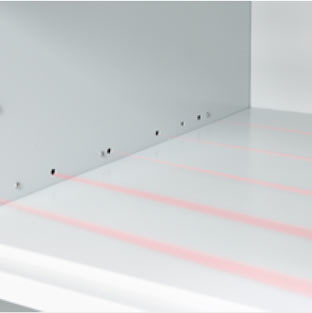
The end-user arrives to collect their parcel from the unused compartment, sees that the compartment is empty, and suspects their item has been stolen or was not delivered. Conversely a user may have more than one parcel in a compartment and not collect them all by mistake, the left behind parcels would be lost if content detection did not warn the end-user the compartment was still not empty.
With content detection, the locker tells the computer when there is something or nothing the medium compartment, and the computer acts accordingly.
Compartment motorized locks
Most locker suppliers use solenoid locks, which are a type of electromagnetic lock. The force to open and close the locker comes from the minimal force generated by its magnets. If too much pressure is applied to the solenoid latch, the magnet cannot overcome the friction, and the locker will not open.
Solenoid locks are prone to jamming when parcels are forced inside, which can happen when an eager delivery person deposits a parcel that is too big for the selected compartment. The parcel puts pressure on the solenoid lock’s latch from the inside of the compartment — this is called backpressure. Backpressure overcomes the solenoid lock’s magnetic force that usually opens the lock and releases the latch. As a result, the locker will not open.
Look for a parcel locker supplier that uses motorized locks as opposed to solenoid locks. Motorized locks have a motor to open and close the lock, and this motor has much more power to release the latch, even when there is backpressure inside the locker.
See how Snaile does it – click here.
Compartment child safety locks
Large parcel locker compartments can be dangerous for children, as they could become trapped inside. So it’s an essential preventative measure to ensure that large compartments have a way to open them up from within, in the same way the law requires car manufacturers to have an inside trunk release latch.
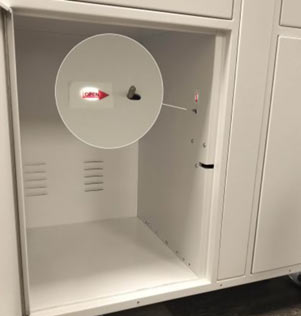
There is plenty to think about when selecting your first-choice parcel locker supplier in Canada. If you’d like to know more or speak to an expert, get in touch with us at Snaile.
We’re officially approved by all major Canadian carriers, and we offer installation, service, and support with an on-site specialist to help you become acquainted with your new lockers when you go live.
See how Snaile does it – click here.


